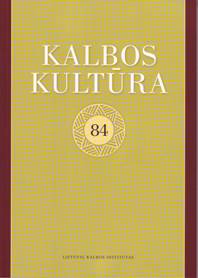Santrumpos: sandara ir sintaksinė vartosena
Shortenings: structure and syntactic patterns of usage
Author(s): Ramunė VaskelaitėSubject(s): Syntax, Baltic Languages
Published by: Lietuvių Kalbos Institutas
Keywords: alphabetical shortenings; syllabic shortenings; mixed shortenings; abbreviations; syntactic relationship; explanatory word;symbolic name;
Summary/Abstract: The paper sets out to examine shortenings in written language, which seems to be gaining importance but so far has hardly been researched. The notion is problematic; it tends to compete and overlap with similar terms, such as abbreviations, alphabetical shortenings, alphabetisms of titles and names, acronyms etc. In the present paper preference is given to shortenings, a largely acknowledged term by Lithuanian linguists. The notion includes three varieties: alphabetical shortenings, syllabic shortenings and mixed shortenings. The choice has been determined by the current usage patterns of shortenings, more precisely, by the tendencies identified in the language of economics.The paper aims at identifying the structure and syntactic patterns of shortenings used in economic reviews published by the National Bank of the Republic of Lithuania. When analysing a large variety of shortenings in present-day Lithuanian and variation in their usage in sentences and longer texts, a number of specific cases have been identified. They are not included in publications dealing with the language norm and should be discussed in reference to the norm. From this point of view, a number of shortenings which seem to be spreading in actual usage have not been given sufficient evaluation yet. They include numbers, words or even symbols; from the structural point of view, they should make a separate category of shortenings. The analysis of alphabetical or syllabic shortenings, the usage of which is mainly regulated by the language norm, has revealed that the issue has become rather problematic due to a rapid spread of nonLithuanian shortenings. The so-called international shortenings, which are fairly difficult to categorise either as purely alphabetical or syllabic shortenings, reopen the discussion of the notions of alphabetical or syllabic shortenings and their boundaries. The above international shortenings also reveal important differences in their functioning in the text. A syntactic approach helps identify two varieties of shortenings: those which tend to be used with other words which grammatically agree with the shortening and those which require explanatory words. The latter type seems to be much closer to symbolic names than to alphabetical shortenings, which are introduced into the text for the purposes of language economy. The paper also discusses a possibility to introduce grammatical markers, which help discriminate between the two varieties of shortenings.
Journal: Bendrinė kalba (iki 2014 metų – Kalbos kultūra)
- Issue Year: 2011
- Issue No: 84
- Page Range: 60-97
- Page Count: 38
- Language: Lithuanian

